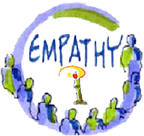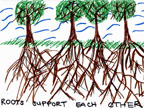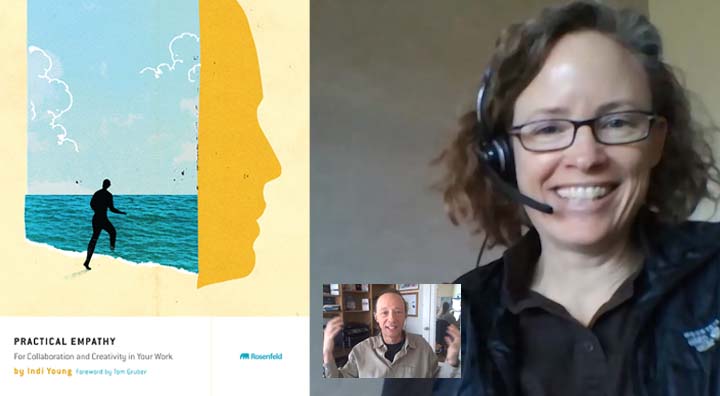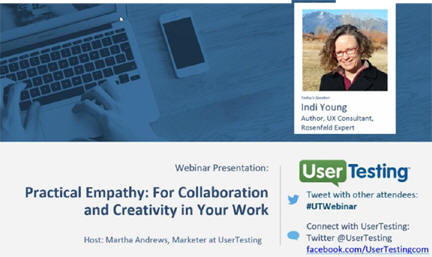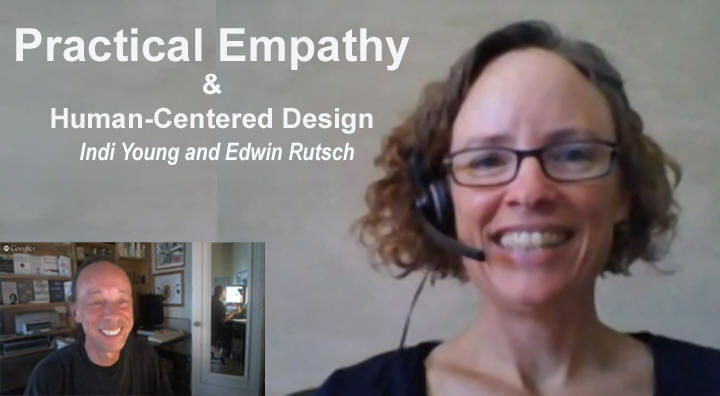|
|
|
Culture of Empathy
Builder:
Indi Young
for empathy, not againstfor empathy, not againstfor empathy, not againstWisconsin Public Radio’s To the Best of Our Knowledge: for empathy, not against A book called Against Empathy came out in late 2016. Author Paul Bloom, a professor of psychology and cognitive science, has consequently gotten a lot of exposure for such an eye-catching title. I’ve found contradictions in what he says. (e.g. empathy means many things vs. empathy is feeling what the other person is feeling) I got a chance to speak with Steve Paulson of Wisconsin Public Radio’s To the Best of Our Knowledge about using cognitive empathy in product design. Podcast: Does empathy have a design flaw?(21 minutes) Transcript below.
Practical Empathy: For Collaboration
and Creativity in Your Work (Webinar with Indi Young)
"Indi: Great! Thank you, Martha. That was a great intro. Hi everybody, presumably you’ve already found the little door in your brain that lets new things in, and you’ve opened it, because we’re going to talk about empathy. Yeah, empathy. That word means a lot of things to a lot of people, and quite frequently it gets associated with little hearts, hearts everywhere. I even see them when other people try to talk about empathy in relationship to the book that I just finished writing."
Through her talk, Indi Young explains how we must ask and listen more as a means to get past our assumptions. Absorbing eclectic ideas, understanding varied work patterns and incorporating different ways of thinking will help broader ideas sprout. She categorizes Empathy into Emotional and Cognitive Empathy, giving us examples of both.
Practical Empathy: For Collaboration and Creativity in Your Work - Indi Young & Edwin Rutsch This is a sample chapter from Indi Young’s new book Practical Empathy.
Chapter 2: Empathy Brings Balance
Practical Empathy: For Collaboration and Creativity in Your Work "The best product managers, designers, product teams, and leaders are experts at practicing empathy. But empathy is not what you think. Ask anyone what empathy is, and they'll say it means to walk in someone else's shoes. And that is part of it. But walking in someone's shoes is how you apply empathy. First, you need to develop empathy. In this on-demand webinar, Indi Young shows you practical ways your team can develop and practice empathy to help understand your users and make better decisions. This webinar is for anyone who is working to deliver useful products, content, and experiences that delight their customers."
Practical Empathy [On-Demand Webinar] In our recent webinar, Indi Young, UX consultant and author of “Practical Empathy: For Collaboration and Creativity in Your Work”, shares some helpful insights on using empathy when soliciting feedback. Here are our top 4 takeaways:
Panel at uxpa 2016
"Empathy is a hot topic in business lately. Teams who go outside their organization to develop empathy for their customers are crafting winning products that deliver on the wants, needs, and desires of their audiences. But empathy not only plays a critical role with those we serve; it also has a vital role inside the team–collaboration is enhanced and individuals are empowered when their own needs and goals are understood."
IxDA 2015: Make the
Case for Empathy - empathy, person-focused research, product strategy
"A note from the editors: In Practical Empathy, Indi Young underscores the importance of developing empathy—and helps us improve our listening, gain perspective, and balance our business practices in the process. We're pleased to bring you this excerpt from Chapter 4 of Practical Empathy."
"To develop empathy, you need to understand a person’s mind at a deeper level than is usual in your work. Since there are no telepathy servers yet, the only way to explore a person’s mind is to hear about it. Words are required. A person’s inner thoughts must be communicated, either spoken aloud or written down. You can achieve this in a number of formats and scenarios."
An excerpt from Practical Empathy explains how to make change on the inside | UX Magazine "Each organization
exists for a purpose: to bring something to the world, make it available to
people, and enable those people to capitalize upon it. Many organizations
exist to also make
a profit. Whether for profit or not, all organizations
seek to sustain themselves, so they can continue bringing their things to the
world. Within each organization, there is usually a healthy awareness of the
purpose, as well as a focus on being sustainably successful."
2015-02-18 -
Webinars:
Practical Empathy: For Collaboration and Creativity in Your Work,
Indi Young
Practical Empathy & Human-Centered Design: Indi Young & Edwin Rutsch
How to Use Empathy to
Build Software Products
"In her presentation, author Indi Young will discuss how to make sure mental models truly represents the root of what is driving your user's natural behavior. It is easy to make assumptions; research often stops at this preference level. However, there is so much more to find out about people. If you learn to listen and notice where you make assumptions about what people are saying or doing, you can learn to dig deeper. Using what she calls the hallway test, Indi will discuss how to stop yourself and ask what is really behind something."
Indi Young – Practical Empathy
There are many kinds of empathy: emotional empathy, mirror neurons,
empathic concern, personal distress, self empathy, and cognitive
empathy. There are also many uses for empathy: to help/relieve, to
persuade, to change someone's mind, to better support a person, etc.
When you say you are using empathy in your work, you probably mean
something different than another person does. So. If you have a better
understanding of all these definitions, you'll be better able to reach
for the right tool at the right moment. Moreover, you'll be able to
understand the differences between what decision-makers need in order to
face risk. You'll be able to articulate the role empathy plays in the
post-industrial creative age.
Empathy - a lot of
concepts around this Definitions Empathy, Sympathy,
Compassion Mirrored empathy -
mirror neurons Personal Distress
Empathic concern Self-empathy -
understand our brain Cognitive -
purposeful understanding with reasoning Emotional -
reflexive Indy is interested
in cognitive empathy create cognitive
empathy with listening also called
perspective taking - understanding them
- take time to let it simmer finding patterns in
what you hear - applied empathy empathy for
persuasion for growth Wants to use
empathy for supporting people better empathy applies to
anything you make gives examples
17:00 Why
is empathy important? old model:
organizations have been designed for manufacturing era measurements
- sounds scientific and safe - false - science persuades versus digital age looking at the the
various relationships and connections. empathy trying to
hear the real story measuring: natural
science verses people 27:00 Cycle
around Ideas v. people Ideas:
think - make - check People:
listen - deepen - apply bring other
peoples voices into your head. This is how
empathy is practical? How? Empathy helps us
pull in more of the human reasoning Your job is about
supporting the customer People want proof
- data driven about new ideas 34:00
quantitative and qualitative are two different measurements with empathy we
are investigating qualitative philosophy is why
are we building this. 38:00 Q and A Talk about
listening to the customer? 1. stop
analyzing - listen and absorb what people are saying 2. help people
open up 3. dive under
the surface - Can we learn
empathy? yes, curiosity is key growing up, I
was scared of other people Education, Knowing
versus Learning mind? like cotton
absorb what people are saying What about
listening to yourself, Internal empathy in an organization, listening
within the organization? more empathy in
teams - hard in large organizations because of silos try to
understand your organization and it's intent, and organize around that. be the empathic
example bring the voices
from people you heard to meetings
Empathy is alive and and well in UX design. Many people apply empathy in their work. The slight problem is that the word “empathy” means different things to different people. And applying empathy doesn’t exactly bring a clear scenario to everyone’s mind. This presentation hopes to remedy this deficiency by providing a practice and vocabulary to develop and apply empathy in your work."
Episode 5: I Drew In A Book - (Book Review)
UX Poland 2014 - Indi Young - Interview
"Puget Sound SIGCHI hosts Indi Young for a full day workshop focusing on empathy. The workshop will cover two types of empathy, intentional and constructed. You will learn how to develop listening skills for empathy, how to interpret and analyze what people have said, identify patterns and incorporate these skills into your practice." "The skill you need is a purposeful, practical form of empathy. Used at organizations, internally or externally, it is a more powerful way to exceed your mission statement than traditional programs for decreasing costs and inefficiency. "
Search
for Empathy Finding Empathy Through Generative Research by INDI YOUNG on March 20, 2012 "
Interviewing for Empathy Finding Empathy Through Generative Research "These days, most people have an idea what user research means. Even outside the usual circles of people we work with, the concept at least correlates to surveys or product testing. For the most part, however, people I run across have a strictly evaluative understanding of user research." "At at recent workshop, I conducted a spontaneous interview as a demonstration of what I mean by "create a scope perimeter within which any conversation can happen." I asked for a volunteer and for a topic. The volunteer was Daren...."
Mental Models, Empathy, and Design
Digging Beyond User Preferences Indi
Young at IIT Design Research Conference 2008 Knowing the motivating philosophy opens up different avenues for
supporting the behavior. You could, for example, offer additional means for
this type of moviegoer to "get the point" of the movie. Mental models are
useful as structures for attaching these ideas to sets of philosophies and for
generating new ideas in places where there are gaps."
|
|||||||||||||||||
|
||||
